
James Clark
-
Posts
174 -
Joined
-
Last visited
Content Type
Profiles
Forums
Blogs
Gallery
Events
Store
Posts posted by James Clark
-
-
This memorial to the Italian airmen and sailors who died in the Spanish Civil War is in the cemetery in Palma de Mallorca. There are meant to be 6 Legion Condor graves there, but I couldn't find them.
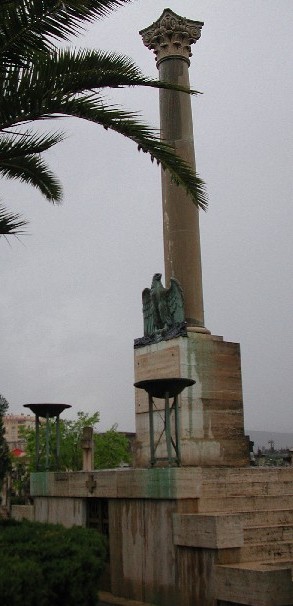
 0
0 -
Yes - this is the regulation I had in mind. Even if someone was entitled to both the 1914-18 Cross for Combatants and also the Cross for for next of kin, they were only able to apply for one version, so had to decide which one they wanted. The entire regulation covering this award is very specific and quite complicated!
0 -
The ribbon at the buttonhole is definitely the KVK - the edge stripes are not the same colour as the central stripe (which is darker).
I also see the two different 1914-18 crosses (for non-combatants and for next of kin). As pointed out above, he shouldn't even have had both, never mind whether he should have worn both. I wondered whether the non-combatant ribbon might have been the 1939 Kriegsverdienstkreuz, but the central stripe looks too wide.
Also, I wasn't quite sure whether that is really a 1938 Treudienst Ehrenzeichen - the arms of the cross look a bit fat. I wondered if it might be another foreign award, although this would mean he had no long service award for anything.
The final three I have no idea about - I thought the crown looked Rumanian or Italian. They look the same, so are perhaps two different classes of the same foreign award. In this case the plain ribbon would have been another foreign medal which he received before getting the second grade of this award. But I'm just guessing now.
Thanks for all your help!
0 -
I wonder if anyone can help me identify the awards on the the ribbon bar in this photo? I think I can get some but lots of uncertainty. I'm guessing the last three are non-German awards. I have blown it up below the picture but it's from a small photo so is a bit blurry.
The wearer is Oberstabszahlmeister zV Johannes Schmidt. That's all I know.
Thanks for your help,
James
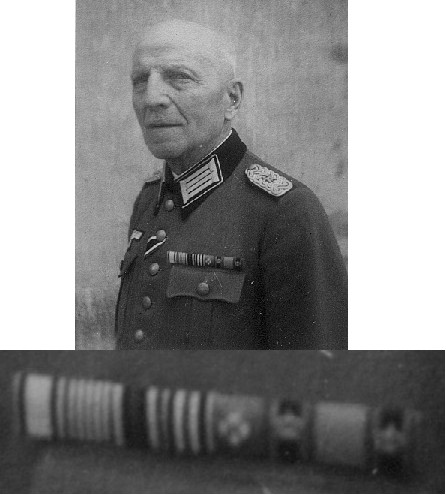
 0
0 -
I'd heard about this. In fact a few odds and ends (collar tabs etc) were sold quite. There was a lot of stuff altogether as his family set up a small museum after Lutze's death, which was looted at the end of the war. Interesting to confirm that it was a Red Cross award rather than the later Volkspflege.
Thanks again,
James
0 -
Yes - thanks, that's the one. I think this picture is from around 1933 if it's the same one I'm thinking of. There is also a colour version where the ribbons are a lot easier to make out. It's interesting to compare these awards with those on the later ribbon bar in the first picture you posted. Very helpful indeed.
0 -
Thanks for this. I have had a bit of a disaster with my computer but have found out some further information e.g. wound badge in silver (for the loss of an eye in WWI). There are pictures of him wearing another imperial or Weimar pin back award that I'm trying to figure out (gold coloured cross worn below his other pin-on awards) but I can't scan pictures at the moment. I hope to get it sorted out soon.
0 -
I wonder if anyone can help me out with a list of Viktor Lutze's awards. He seems to have had quite a few Imperial awards.
Thanks
James
0 -
Thanks Robin - that's what I thought but can't find where I read it. While we're about it, what about the RAD 25 year Long Service - ever awarded or known not to have been?
0 -
I was wondering if it is known for certain whether the SS Long Service Award for 25 years was ever actually awarded. If so, are any of the recipients known?
Thanks!
James
0 -
So Rick, does this indeed strike you as being for Customs or would it be more for their version of the IRS?
d
It's for a tax official. If it had been for Customs, he would have been a Zollanw?rter (though it would still have been signed off by the Finanzamt).
James
0 -
There is nothing unusual about the Spanish Civil War medal or Sudetenland medal, or indeed the back of the ribbon bar, so I won't bother posting pictures.
I suppose we can only guess at the career: a medic in the First World War who had a break from the Armed Forces before joining the Luftwaffe probably in the early 1930s, which only gave him enough service time to qualify for the 4th class Long Service Award. Then he went off and did something in Spain that was enough to qualify for the Civil War medal, although he must have been back in Germany to do something in 1938 that qualified him for the Sudetenland medal. The ribbon bar suggests that he was still in some sort of uniform in 1939.
As I said, a completely anonymous group, but I like it very much. And I have learned a bit about Imperial Awards from it too - from here: http://gmic.co.uk/index.php?showtopic=11806
0 -
There is a nice detail on the reverse.
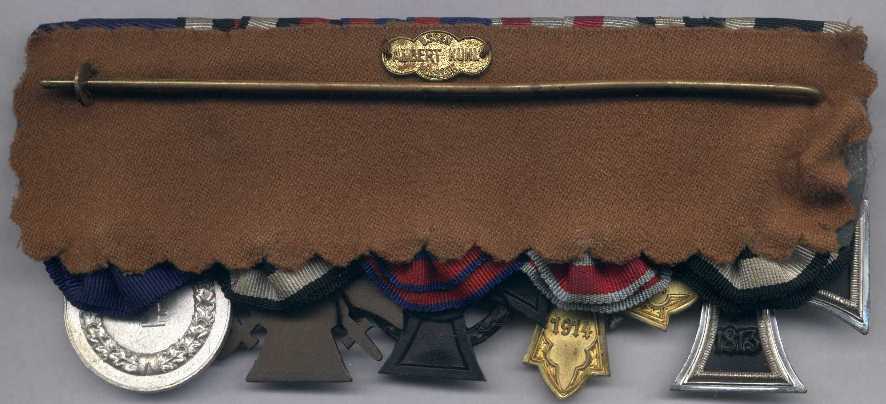
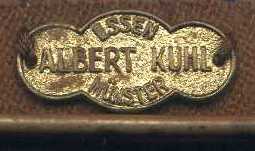



 0
0 -
But the full size medal shows that it is the Military Medical Cross on wartime ribbon.
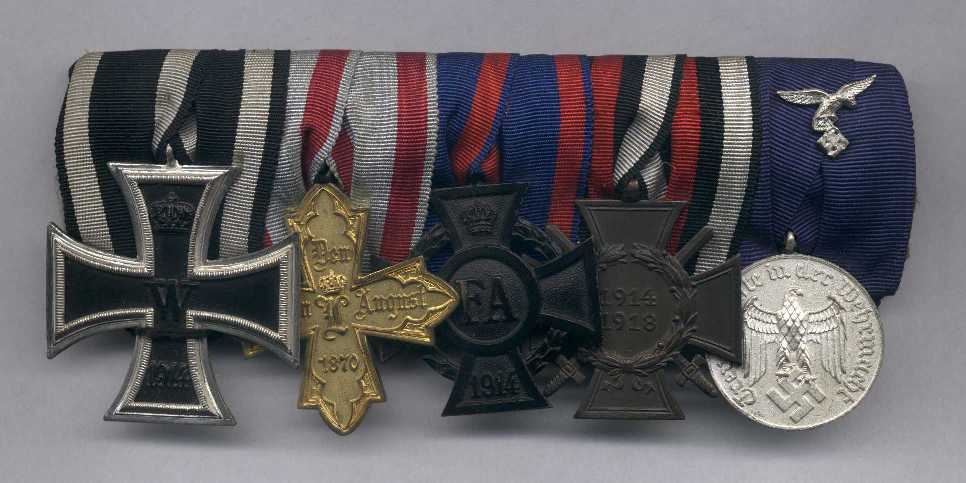

 0
0 -
From the ribbon bar alone the second ribbon could have been a number of Hesse State awards.


 0
0 -
I found this group recently and was very taken by it. It is completely annonymous as there was no paperwork with it - not even a story from the person I bought it from!
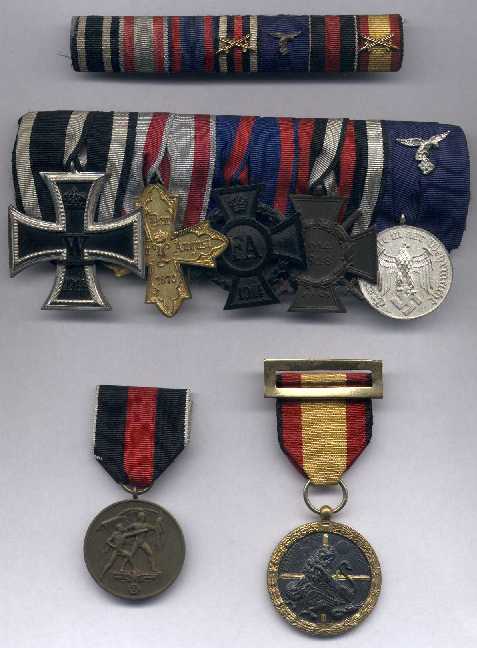

 0
0 -
Thank you all for the information and for taking an interest. I am now going to post some further pictures on the Spanish Civil War forum. I hope you like how it continues.
Regards,
James
0 -
Hello
I was wondering what the difference was between the gilt version of the Hesse Military Medical Cross 1914 on this group and the bronze version I have seen elsewhere. Was it rank related? Also, should the cross be the other way round, with the 1914 date showing?
[attachmentid=56448]
Thanks
James

 0
0 -
Warlord - thanks for the information confirming Godet as the manufacturer. And for showing such a high quality example.
Peter - I would be interested in any more details you can give about Raemisch being the designer. I have heard this before (it appears on a US militaria dealer's site) but I wonder if this might be the result of a misunderstanding. Professor Walter Raemisch is mentioned in the official report of the 1936 Olympics as having designed the Olympic Badges (with the Brandenburg Gate and Olympic rings) worn by participants and officials at the Games. He also designed the badge for visitors. But I have not seen anything convincing to say that Raemisch also designed the Olympia-Ehrenzeichen.
James
0 -
Now that you mention it, there is a picture of a mounted 2nd class in Detlev Neimann's book that has a tailor's label for Godet sewn onto the back. That doesn't mean that they made it of course. There is also a 1st class pictured in JR Angolia's book on Political/Civil awards that has the number 38 on the back, but the author says he doesn't know what this stands for. Anyway, Godet seems most likely to me, but I still can't back that up.
James
0 -
Even looking back through the documents in this thread we can see an example of an Oberst being awarded the Bronze grade without swords and a Major (two ranks lower) receiving the Silver. So rank doesn't seem to have played a role.
0 -
I thought you might find the following information useful.
The statutes for the Spanienkreuz dated 14 April 1939 give the following information:
The Spanienkreuz was awarded in 3 classes - Gold, Silver and Bronze. Hitler reserved the personal right to bestow the Gold award with Brilliants for especially outstanding efforts.
The Spanienkreuz was to be awarded either with swords or without swords, but only the Silver and Bronze grades were awarded without swords.
The Spanienkreuz with swords was to be awarded to the volunteers of the Condor Legion ("Freiwillige der Legion Condor"). It could also be awarded to the crews of the ships of the deutsche Kriegsmarine that took part in the following combat actions in Spanish waters:
1) The air-raid on Ibiza
2) The shelling of Almeria
3) The bombing of Palma
The Spanienkreuz in Silver or Bronze without swords could be awarded to:
1) Courier pilots
2) Members of the Wehrmacht who were attached to the Legion Condor in Spain in the course of their official duties or spent at least three months on ships of the Kriegsmarine in Spanish waters
3) German civilian volunteers (Zivil-Freiwillige) belonging to the Legion Condor and in official German posts that had the same purpose as the Legion Condor
So there are two types of "Freiwillige":
1) the members of those units that formed the Legion Condor proper. This underlines the point, sometimes overlooked, that not every German who served in Spain was a member of the Legion Condor: the Wehrmachtsangeh?rige who supported or were attached to these units were clearly not considered "Freiwillige der Legion Condor".
2) German civilian volunteers who either served with the Legion Condor or else supported its aims through the work they did. The German text is "deutsche Zivil-Freiwillige der Legion Condor und der mit ihr in gleichem Auftrag t?tigen amtlichen deutschen Stellen". The only example I have found of a non-military recipient is a document for the Silver grade without swords awarded to Diplom-Ingenieur Joachim von Richthofen (Forman's Guide to Third Reich German Documents, Volume 1, page 12) about which I have no further information. The document does not refer to him as a "Freiwillige".
The statutes don't give any information about what differentiated the Gold, Silver and Bronze awards.
0 -
Does anyone know who designed the 1st and 2nd Class awards? Or who made them - I always though Godet but don't have anything to back that up.
I've also noticed from the few pictures available of the cases that the 1st Class usuallys seem to have the dome-headed push stud while I've only found pictures of the 2nd class case with a rectangular push-stud. Anyone know any more on that?
Thanks
James
0 -
Dear Steen
Thanks for this additional information - all very useful.
Regards,
James
0


Italian Legion medals for Spain
in Spain
Posted
The inscription reads "Ai Marinai e Aviatori d' Italia caduti in Spagna che qui riposano 1936 1939"